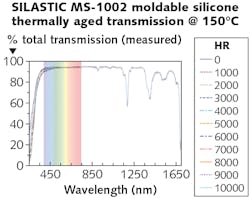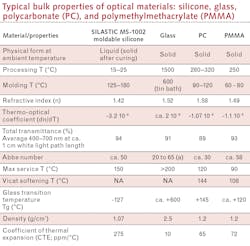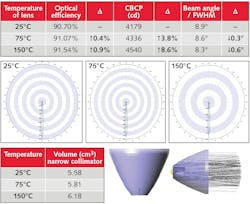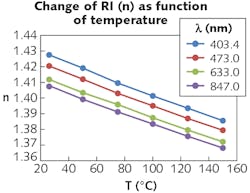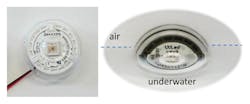Optical Materials: Moldable optical silicone elastomers spark creativity in LED lighting
MARTIJN BEUKEMA, MICHELLE CUMMINGS, FRANÇOIS DE BUYL, JAKE STEINBRECHER, BRAD TUFT, and KEVIN VAN TIGGELEN
Luminaire manufacturers have traditionally used glass or optical thermoplastics like polycarbonate (PC) and polymethyl methacrylate (PMMA) for producing optics. However, increases in LED power for high-lumen applications are placing new demands on traditional materials. As heat generated near the LED steadily increases, these materials can degrade. Yet high-power, high-heat luminaires must be pursued to maximize the energy-efficiency advantages of LEDs.
But there is a solution: Optical-grade liquid silicone rubber (LSR) is becoming the material of choice for optimizing the use of LEDs. Liquid silicone rubber is used in a growing number of indoor and outdoor lighting applications.
This article, illustrated by case studies, describes the performance and design benefits of moldable optical silicones for applications such as high-performance LED lamps and luminaires. These advantages include ultraviolet (UV) stability; resistance to high heat, scratching, and impact; and enhanced design capabilities for total internal reflection (TIR) optics and freeform lenses.
The article also discusses the need to account for the influence of the coefficient of thermal expansion (CTE) and thermo-optical coefficients (TOCs) when designing optics with silicone materials and presents strategies for ensuring optimal integration of optical silicones within LED lighting modules.
Unique benefits of silicone
Silicone materials display unique characteristics resulting from the unusual combination of an inorganic chain, similar to silicates or glass, which is often associated with high surface energy, and side methyl groups that are organic and associated with low surface energy.1 Compared to many organic materials, the chemical backbone of silicones makes them particularly well suited to manage the increasingly high temperatures and light flux of LED lighting systems.
In addition, the higher difference in electronegativity of silicon (Si) vs. oxygen (O) atoms compared to carbon (C) vs. O atoms turns Si-O bonds to be very polarized and highly ionic character, therefore larger bond energy.2 This explains the high heat and UV stability of the Si-O-Si dimethylsiloxane backbone used in moldable optical silicone for LED lamps and luminaires, as well as their outstanding flame retardancy performances.
Optical materials comparison
The properties of moldable optical silicones, glass, polycarbonate (PC), and PMMA (acrylic), compared in the table, illustrate differences in key bulk materials characteristics. The unique properties of optical silicones based on polydimethylsiloxane (PDMS) polymer and siloxane resins give them mechanical strength and toughness for freeform lenses or light guides after crosslinking during the injection molding process.The high heat stability of LSR is illustrated by SILASTIC MS-1002 moldable silicone, an optical-grade LSR (see Fig. 1). After 10,000 hours of accelerated aging exposure to 150°C, the optical silicone remains perfectly transparent in the 400–800 nm visible-light range.
Optics made with silicone materials are also extremely resistant to UV radiation. They show no signs of yellowing nor any degradation in mechanical properties after exposure to harsh outdoor environmental conditions.3
Their relatively low haze of 2% to 3% makes optical silicones appropriate for most LED lighting applications. An Abbe number on the order of 50 indicates that optical silicones do not cause significant dispersion of visible light wavelengths within the material. This low dispersion enables good control of white-light beam homogeneity from a TIR lens, collimator, or light guide, similar to PMMA. Compared to PMMA and other thermoplastics, however, optics molded from silicone elastomers will not soften or melt under high temperatures. Instead, under long-term, permanent, and intense heat, silicone optics can harden progressively.
Another important consideration is that LED lamps and luminaires always operate in a temperature range well above the glass transition temperature of moldable optical silicones. In consequence, when properly designed and mounted onto the lighting fixture, optics molded from silicones can deliver high impact protection (IK) and ingress protection (IP) ratings.4
SILASTIC MS-2002 moldable silicone, a white, highly reflective silicone with high stability under heat aging and a perfectly Lambertian distribution of reflectance, was developed for use in reflectors and mixing chambers for enhanced light distribution homogeneity (see Fig. 2).Designing optics with moldable silicone elastomers
Designers using optical-grade silicone materials need to consider thermal effects, including the coefficient of thermal expansion (CTE) and thermo-optic coefficient (TOC). Given the CTE of 275 ppm for SILASTIC MS-1002 moldable silicone, the volume of a TIR lens for a 9° beam angle collimator increases by almost 11% as the temperature rises from 25° to 150°C, but only 4% from 25° to 75°C (see Fig. 3). Due to increasing temperature, both optical efficiency and center beam candela power increase (an effect of the negative TOC value) and beam angle decreases slightly (an effect of volume increase of the TIR lens).Injection molding of optical silicones
Moldable optical silicones are two-component, viscous liquids that must be mixed in a 1:1 ratio by weight to produce a solid part after heat curing. The underlying chemical reaction, known as crosslinking, occurs when a vinyl-terminated polysiloxane is added to a Si-H functional polysiloxane oligomer in the presence of a platinum catalyst.5
The liquid form of moldable optical silicones allows injection at room temperature and at relatively low pressure through small gates, showing good flow lengths in thin-wall sections. Compared to thermoplastics, a liquid-silicone injection-molding press can run effectively at relatively low pressures and moderate clamping forces. A relatively low viscosity at room temperature (15° to 25°C) combined with the drop-in viscosity during mold filling enables perfect replication of microsized features with small radii of curvature, such as Fresnel lens patterns.
The material is released from the mold in a solid form after being cured at high temperature (approximately 125° to 180°C). Cold runners allow direct gating on the part so silicone optics can be produced with an optimized mold design that minimizes waste and reduces gate sizes. Gate sizes are typically around 0.2 mm for small optics and up to 1–2 mm for large and thick optics, and therefore have a minimal influence on optical performance. These small gates do not require labor-intensive post-finishing steps.
Case studies of moldable optical silicones
Recently, there has been growing interest from designers in optical silicones for enhancing the performance of lamps or luminaires.6 For instance, collimator designs with negative draft angles can be produced using industrial-scale injection molding of optical LSR (see Fig. 5).7Advanced silicone optics have demonstrated their value in high-power LED lighting fixtures and, therefore, high-photothermal-load applications (up to 35,000 lumens).
In the area of LED lighting for streets and roadways, VS Lighting designed a cost-effective module with high ingress and impact protection ratings (IP67, IP69K, IK08).10 The optical silicone and silicone adhesive used in the LED module provide strong resistance to outdoor UV light and impact. Importantly, PDMS-based materials are permeable to volatile organic compounds (VOCs), helping prevent contamination of the LED die or its light-converting phosphor layer.11
In exterior automotive applications, SoundOff Signal (Hudsonville, MI) designed an LED lighting module for emergency vehicles using two optical LSRs. Here, the specially designed clear lens is molded from SILASTIC MS-1002 moldable silicone. This lens is then co-molded with SILASTIC MS-0002 moldable silicone to form the housing. The LED module has a small footprint with maximized candela output, outstanding resistance to damage such as gravel pitting, improved sealing performance to prevent water entry, and high UV and photothermal stability to prevent lens yellowing.12
In another example,13 optical silicones are being used to fabricate primary lenses with multisegmented LED light sources for adaptive driving beam (ADB) headlamps to improve the safety of drivers and roadways.14 Adaptive driving beam technology allows drivers to keep their high beams on permanently because the system automatically adjusts intensity in response to varying traffic and road conditions.
From a manufacturing standpoint, injection-molding press suppliers and mold tooling companies have collaborated to improve automation of the liquid injection-molding process and associated quality control. The result is cost-effective production of silicone optics with multiple light guides (see Fig. 8).19Dow and Surcotec have explored the application of a metallic reflective coating such as aluminum or gold offering high optical specular reflectance.16 The combination of plasma- enhanced chemical vapor deposition (PE-CVD) and magnetron sputtering technologies were proven effective for applying a well-adhering aluminum metal layer on surfaces of silicone optics. This process may find applications in various areas of LED lighting, as well as solving the difficulty in applying metallic coatings on optical PMMA.
Applications for silicone optics beyond illumination have also been explored. In one case, Philips Lighting used deep UV-C LED radiation for water purification, thanks to the high stability and transparency of optical silicone in the region of 270-300nm.17, 18 The module shown in Figure 9 was designed with an optic window made of SILASTIC MS-1003 moldable silicone (50 Shore A) that offers the possibility to reach IK-10 and IP-68 ratings at the UV-C LED module level.Recent developments aim to improve integration of silicone optics into the LED fixture, for instance, by overmolding optical LSR onto thermoplastic substrates.15 In Figure 10, the optical silicone is overmolded onto 30% glass fiber polybutylene terephthalate (PBT). The two- or three-material injection-molding process can enable multiple-function LED light engines by combining rigid but brittle thermoplastics and flexible but tough silicone elastomers.
FIGURE 10. A SILASTIC MS-1002 moldable silicone was overmolded onto 30% glass-reinforced PBT thermoplastic. The demonstration part design is by DOW–Gaggione.(Courtesy of Dow)
SILASTIC MS-2002 white reflecting moldable silicone was found significantly more convenient for the design of a parabolic reflector and its installation in a recessed downlight fixture than traditional reflective films or coatings, as illustrated by a case study with Pathway Lighting Products, Inc.20 The use of SILASTIC MS-2002 white reflecting silicone made it possible to control the CCT from 2100 K to 4300 K with a constant reflectance across the whole light spectrum and a wide range of light incidence angles. The very high mechanical and optical stability of SILASTIC MS-2002 moldable silicone at temperatures as high as 150°C (tested up to 6000 hours) without turning yellow or showing physical degradation, as well as a thermal conductivity of 0.46 W/mK, are also strong attributes that can help ensure long-lasting performances of luminaires, even if they are exposed to harsh environmental conditions.
Conclusions
Optical moldable silicones deliver outstanding performance in demanding environments, including high heat, high humidity, and UV exposure. They combine excellent optical properties with resistance to yellowing, scratches, cracks, vibrations, gravel pitting, and other damage that may limit glass and thermoplastics.
From a design standpoint, the flexibility and consistent mold replication of silicones enable complex optical shapes, fine surface features, and integrated mechanical features more difficult with traditional plastics. Injection molding allows high throughput and lowers stress on molding tools.
Dow offers LED lighting designers and manufacturers of optics components a team with expertise in materials science, optics, and injection-molding tools and processing technology for LSR.
REFERENCES
For the complete list of references, please see https://bit.ly/Oct19References.
Martijn Beukema is Technical Service & Development Optical Engineer, Michelle Cummings is Research & Development Chemist, François de Buyl is Technical Service & Development Scientist, Jake Steinbrecher is Technical Service & Development Engineer, Brad Tuft is Research & Development Chemist, and Kevin Van Tiggelen is Technical Service & Development Injection Molding Engineer, all at Dow, Brussels, Belgium and Midland, MI; e-mails: [email protected] and [email protected]; www.dow.com.
